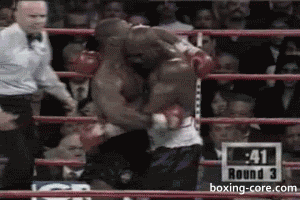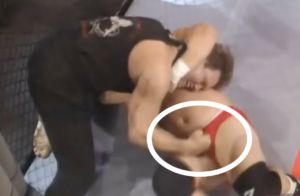Many people learn martial arts to learn how to handle themselves in a real fight. But many martial arts are sports and sports have rules while street fights don’t. That means many things happen in fights that aren’t allowed in certain martial arts.
Although it started out as “no-holds-barred”, mixed martial arts has rules today. Headbutts, groin strikes, eye pokes, biting and stomping a prone opponent, for example, are all banned. That creates an interesting question: How effective are these “illegal” moves in a real fight?
Luckily for us, and unluckily for those who have fallen victim to them, we have seen a few incidents of these prohibited techniques being used over the years, often against the rules, either in MMA or other sports. So we have gotten a look at how effective they are in a fight.
Some have been proven entirely legitimate, based on what we’ve seen, while others might not be nearly as deadly as movie fight scenes might make them seem.
Head Butts – Illegal in Modern MMA and Boxing
In the movies, we see bad guys get knocked out with a head butt by the good guy. But, in reality, does it work that way? Not so much.
In boxing, head butts happen accidentally all the time but usually, they just cause cuts and bruises. People aren’t knocked out by head butts very often, if at all.
In the early UFCs, head butts were legal but it’s never caused a fight to be stopped, even when used on the ground. Ken Shamrock used head butts to pulverize Royce Gracie’s face in their rematch, but it wasn’t so bad that Gracie couldn’t fight on. Mark Coleman was another wrestler who used head butts a lot but never knocked anyone out with one.
So, are head butts fight-ending? It seems they’re not when we’re talking about professional fighters, where they cause a lot of cosmetic damage. But when drunk people surprise one another with them, they’re devastating.
Hammer Fists – Illegal in Boxing
Hammer fisting was allowed in boxing hundreds of years ago, when it was part of the old Greek Olympics. These days, it’s not allowed in boxing since those gloves aren’t padded along the side.
In mixed martial arts, the gloves also have no padding on the side but hammer fists are totally allowed. What have we seen happen? People love to hammer fist in MMA and it works very well, although not everywhere.
We don’t often see anyone use hammer fists while on the feet – but spinning back fists are sometimes seen. Hammer fists, usually, happen when either one fighter, or both, are on the ground and a good downward angle is made for dropping hammer fists effectively.
We often see it happen when a fighter is in the guard, and looking to land a hard downwards blow, but the real results are when it is used to follow-up on a knockdown. Rather than look for a submission, a fighter will drop a series of hard hammer fists to the head of an already-stunned opponent. In some groups, this technique is called “nailing shut the coffin” as it usually finishes off the fight.
So, has the hammer first been proven effective? Yes, it has, as a finishing blow to a grounded opponent. Used on the feet, not many have put to use effectively yet.
Heel Hooks – Illegal in BJJ
Heel Hooks are illegal under IBJJF rules, but allowed in many other grappling events such as the Eddie Bravo Invitational and the Abu Dhabi Submission Wrestling world championships. When allowed, heel hooks are far-and-away the most used submissions seen in the events, vastly outnumbering other submission holds in terms of winning-est techniques.
They are also seen from time to time in mixed martial arts. Rousimar “Toquinho” Palhares won quite a few fights using nothing else, and was feared for his leg-locking skills, not to mention his district tendency to continue with the hold even after opponents tapped.
So, as there’s no question that heel-hooks are effective, why don’t we see more of them in mixed martial arts? It could be because many fighters aren’t comfortable with them and would rather not sacrifice positions to go after leg locks; especially when it could mean taking punches from your opponent in the process.
And the IBJJF? Why do they persist in leaving heel hooks on the list of prohibited submissions? Some would say it’s because a heel hook is able to cause much more damage than other leg locks, and it isn’t something for amateurs to toy with competitively.
A second idea is that the move is so effective, allowing people to use it changes the game totally, just as we’ve seen in other events where heel hooks have taken over to the point of being the only moves used at all.
Slamming – Illegal in BJJ
Slamming is when a person is lifted off the ground and then is powerfully smashed back onto the floor. Anyone who is a fan of MMA will recall the ultimate slam; which happened years ago in Pride where Ricardo Arona was lifted and slammed by “Rampage” Jackson. The result was devastating and Arona was knocked out cold.
For safety reasons, slamming is illegal at most Brazilian jiu-jitsu tournaments but there are still a few events that allow it, such as the ADCCs. Surprisingly, we don’t see many injuries because of it, as fighters are wary to the danger of being slammed and take steps to avoid it.
So, is slamming effective? Absolutely, if a person allows themselves to be lifted.
Groin Strikes – Illegal Everywhere
Is there any debate about whether these hurt? No, of course not. Every man knows what it’s like to get hit in the groin. It’s awful, but is it a fight-ender?
It’s hard to say. Fighters in mixed martial arts will often cry foul when they’re hit in the groin and, if the referee stops the match, will take time to recover. But, when a referee doesn’t stop it, many just fight on.
Also, the early UFC events actually allowed groin strikes and a few fighters fell victim to this. But did any fights in the early UFCs end by groin strike? There was the fight between Keith Hackney and Joe Son, but even in that, it seemed the groin shots weren’t so much the end of that fight, although they certainly were nasty.
So, are groin strikes a guaranteed KO? No, they aren’t. Still, they hurt a lot.
https://youtu.be/EhHoeSc9CrE
Eye Pokes – Illegal Everywhere
Along with groin strikes, eye pokes happen quite often by accident in mixed martial arts. And fighters usually take a few minutes to recover. If they aren’t given any time to recover, they usually fall victim to a flurry from their opponent who senses their opportunity to put an end to things.
That being said, Yuki Nakai vs. Gerard Gordeau was a fight from years ago where Nakai was eye-gouged so badly, he later went blind in that eye. Yet he still made Gordeau tap with a heel hook.
So, what have we learned? A quick poke to the eye can be debilitating, but slowly gouging your opponent’s eye can lead to them getting angry and breaking your leg if they’re a better grappler.
Soccer Kicks & Stomping – Illegal Almost Everywhere
Everyone knows the term “kick a man when he’s down” and understands what it means. But has it happened to you in a real fight? If so, you know it better than most.
In the UFC, it’s illegal to kick a person who is “down” but years ago, it was totally allowed. Also, it was allowed for fights in Pride and used a lot. How did it work for them?
Many fighters were able to defend themselves from any stomps and soccer kicks by using their guards, but not everyone escaped unharmed. Perhaps the worst kick anyone ever took while down was many years ago when Renato “Babalu” Sobral fought Brad Kohler. Check it out and you’ll see why it’s illegal in the UFC these days.
There’s no question that stomps and soccer kicks can KO an untrained or unprepared adversary. Against an opponent who is ready for them it’s not the same, but they still work.
Biting – Illegal Everywhere
No event has ever allowed fighters to bite one another. Still, it has happened in some fights. As everyone saw years ago, Mike Tyson bit the ear of Evander Holyfield. Ryan Gracie once bit off part of someone’s ear in one of his old challenge matches and Matt Lindland once bit an opponent at a wrestling meet.
What happened? Well, each time, the person who was bitten jumped and shouted – but it didn’t really change the outcome of the match in most cases.
It shouldn’t come as too much of a surprise. People are not crocodiles or sharks, after all. A human mouth isn’t able to do as much damage as nearly any other animal, comparatively speaking. Losing bits of ears and fingers might be the worst-case-scenario.
So, does biting work? Sure, but it might not be a fight-ender as much as a way to alarm and anger someone. Just like kissing means “I love you”, biting someone is like saying “We’re in a fight to the death”.
This “raising of the stakes” idea is something all of these “illegal” moves have is common, so they should only be used in a real fight when your life is actually on the line and you have no other choice. Otherwise, you could land in hot water legally-speaking if your attacker ends up maimed or crippled and it can be proved that you used one of these techniques on him.
The safest technique in a fight is still a choke, because nobody can fight you when they’re unconscious.
